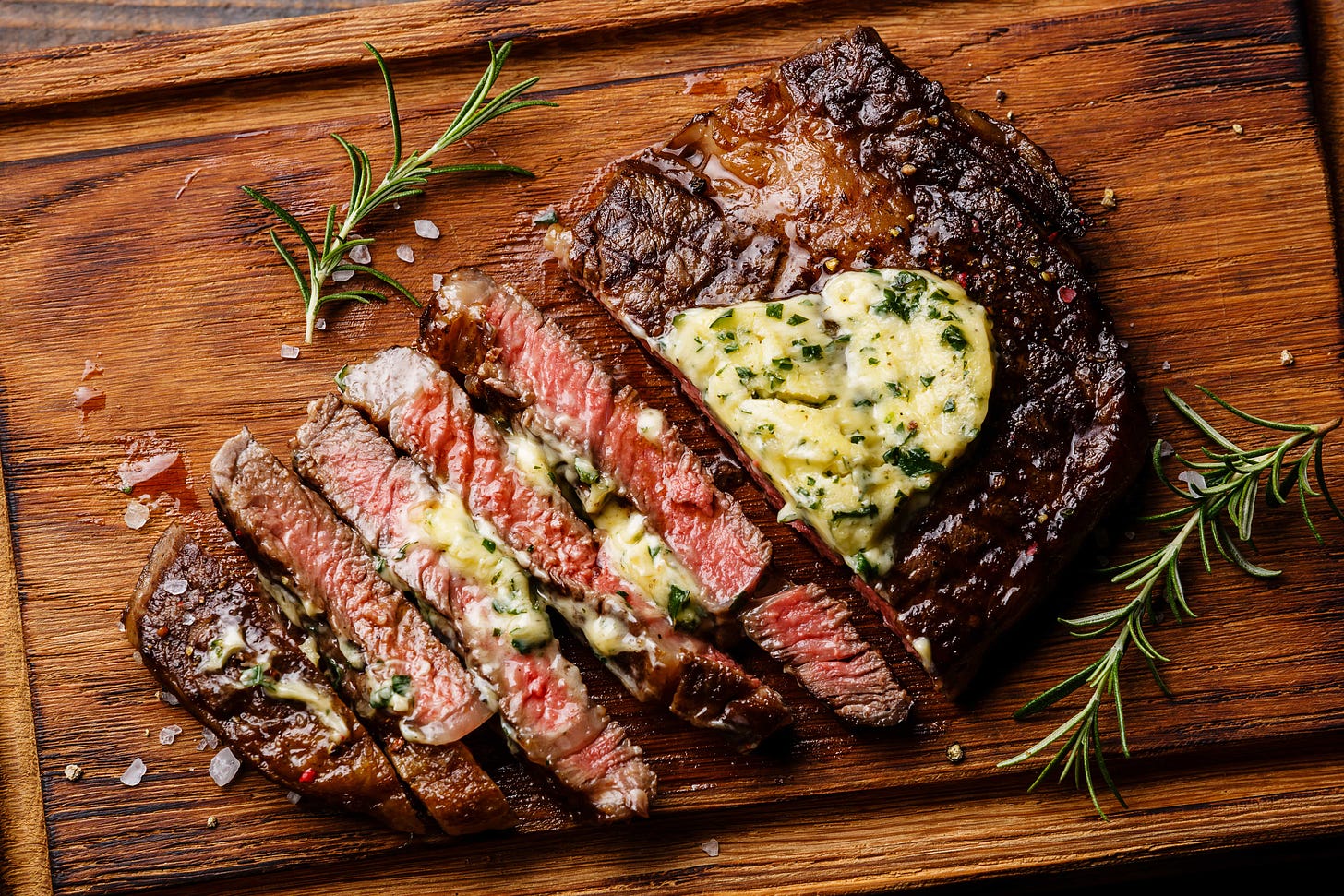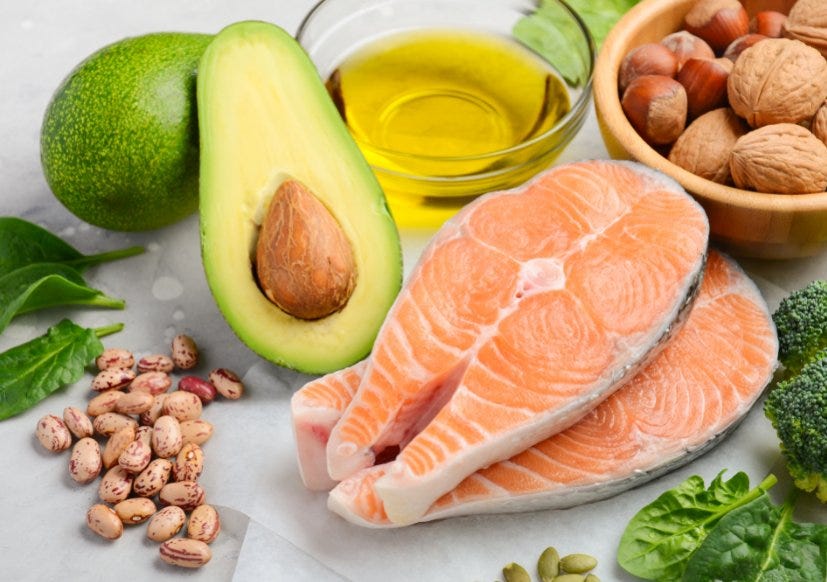Dietary Fat: Not 1 Size Fits All
A simple explanation of good and bad fats (why you should avoid seed oils), and how to determine if high or low fat is better, and whether high or low saturated vs monounsaturated is right for you.
The Upshot
Eat a variety of natural fats from whole foods like meat, fish, nuts and seeds, making sure to balance your intake of Omega 6 and Omega 3 fats (eat far more Omega 3s and less Omega 6s).
If possible choose organic, pasture raised meat and wild caught, low pollutant-level fish.
When cooking, avoid reaching the smoke point at which an oil starts to burn.
Sensitive oils high in Omega 6 and 3 fats should be cold pressed, stored in dark containers and eaten raw rather than heated.
Avoid margarine and any refined and processed seed oils like canola/rapeseed, corn, cottonseed, soy, sunflower, safflower, rice bran, and grapeseed.
If you are metabolically healthy you can experiment with high fat, low carb vs low fat, high carb - there have been healthy human cultures utilizing both templates. However if you are metabolically unhealthy (overweight, metabolic syndrome, diabetes, heart disease, etc) then you will usually do better with high fat, low carb at least initially.
Also experiment with high saturated fat vs high monounsaturated fat (e.g. olive oil).
In these experiments look for which diet better optimizes your energy, mood, sleep, sexual health, body fat, exercise recovery, muscle growth, blood pressure, heart rate, heart rate variability and blood tests like hormones, inflammatory markers, etc.
The Details
Nature doesn’t make bad fats.
Natural healthy fats from meat, fish and plants contain varying concentrations of: saturated, monounsaturated, polyunsaturated and naturally occurring healthy trans fats like CLA, cholesterol and phytosterols (not all trans fats are bad! Natural CLA in meat may reduce the risk of coronary artery disease). The polyunsaturated fatty acids (PUFA) found in highest concentrations in seeds and fish are composed of Omega 6 and Omega 3 fatty acids, both of which are thought to be required in approximately equal amounts for optimal health (pre industrial societies' Omega 6:3 ratios ranged from 4:1 to 1:4), but modern diets are about 15 times higher in Omega 6 compared to Omega 3.
Both saturated and monounsaturated fatty acids (MUFA) are chemically stable enough to resist oxidation (i.e. rancidity) even when exposed to heat and the more sensitive polyunsaturated fatty acids (PUFA), in their naturally occurring form in whole foods (seeds and fish), are protected from oxidative damage by naturally co-occurring antioxidants. The only way to safely extract these oils from seeds and fish is by a gentle and slow, cold-press process.
However when oils high in PUFA are industrially refined they become chemically unstable and the high pressure and heat required to extract them at scale oxidizes a significant portion, creating a terribly rancid smell, as well as creating carcinogenic polycyclic aromatic hydrocarbons and atherogenic oxyphytosterols. The deodorizing process required to remove the noxious odor triggers the production of unnatural and harmful trans fats (primarily elaidic acid) - making up as much as 5% of the final product.
The only reason labels can claim 0 trans fat on vegetable oils is because of lax laws: if an ingredient makes up less than 0.5g per serving it can be falsely claimed the product doesn’t contain it at all. However with normal use the amount of harmful unnatural trans fats ingested in a day will usually exceed recommended levels.
The oxidized fraction of the final product is unstable and requires the addition of powerful and toxic antioxidants like TBHQ (carcinogenic and immune and endocrine disrupting) - but when ingested and separated from the antioxidant the oxidized fats create free radicals that further oxidize any fats they come in contact with. The newly oxidized fats further spread oxidative damage to other normal fats. This process damages cells and places a significant burden on our bodies' antioxidant systems.
The primary Omega 6 fatty acid found in seed oils is linoleic acid which is easily oxidized when incorporated into our blood cholesterol (LDL) after a meal and this triggers the development of atherosclerotic plaques in arteries. Interestingly the Omega 6 fat arachidonic acid found in animal products does not contribute to atherosclerosis in this way and although historically it was thought it migh tbe pro inflammatory, that is not the case - it is both a precursor to necessary inflammatory compounds as well as anti inflammatory compounds (not all inflammation is bad - we need inflammation to first start and then stop, rather than becoming chronic: e.g. during exercise and recovery).
Omega 3 fatty acids are also easily damaged during extraction and storage, which may help account for why results of studies on fish oil supplementation have been mixed (that plus other confounders like toxins in the fish and bad study designs). There are some artisanal producers of fish and flaxseed oils high in Omega 3 fatty acids, but whole food sources are optimal since, again, they have natural antioxidants to help stabilize the fats.
With chronic consumption of industrial seed oils, partially oxidized PUFAs will make up a higher percentage of body fat. Between the 1950s and 2005 the average amount of PUFA in human body fat went from about 10% to nearly 20%. After stopping consumption of seed oils it will take some months for your body to replace these pro inflammatory fats with regular healthy fats.
Animal/Fish Diets Alter Their Nutritional Profiles
Animals fed their natural diets like cows grazed on grass have a different fat profile than those fed an unnatural diet like grains. For example pastured cows have a much higher amount of Omega 3 fats in their meat.
Farm raised salmon can have an insignificant increase in their Omega 6 to Omega 3 ratio, but often have higher overall Omega 3 content and much higher saturated fat levels than wild salmon. But farmed salmon may also have significantly lower mineral content. Farmed salmon are also exposed to antibiotics.
Toxins
Toxins found in animal fats include pesticides and mycotoxins - both come from the grains the animals are fed. Most animals are also exposed to antibiotics and hormones.
Fish contain a significant amount of mercury, but levels don’t vary between farmed and wild fish. Thankfully mercury is bound by selenium and mercury containing fish are likely safe to eat as long as selenium levels exceed mercury levels - as they do in all commonly eaten fish (avoid pilot whale, tarpon, marlin, swordfish and some shark species).
However farmed salmon do have 16 times the level of the industrial pollutant PCB (polychlorinated biphenyl) as well as higher levels of toxaphene, dieldrin, dioxins, and polybrominated diphenyl ethers. Among farmed salmon these toxins occurred at higher concentrations in European farm-raised salmon than in farmed salmon from North and South America. Still fish are a lower source of these industrial pollutants than conventional meat and vegetables.
Individualizing Your Fat Intake
Humans in different locales have thrived with varying amounts of fat and carbs as well as different kinds of fats, e.g. some of our ancestors did very well on high fat diets and others did well on high carb diets, some had high saturated fat diets and others had high monounsaturated fat diets. It is likely that these varying environments selected for those people with the genetic makeups optimized to them and that a gene environment mismatch may lead to suboptimal health or even disease.
For example there are some genetic SNPs (FTO, PPARG, PPARA, FADS2) that may help determine an individual's relative predisposition to developing obesity, diabetes, and heart disease when on a high saturated fat diet, but this approach may be too simplistic to rely on since there are so many other environmental inputs that also have an effect as well as unknown genetic factors that may modulate the above.
So the best approach is likely to personally experiment with high fat vs low (healthy whole) carb and high fat vs high monounsaturated fat diets, while maintaining adequate Omega 3 to Omega 6 ratios, to see the effects these different dietary approaches have on important health markers, while remaining cognizant that there will usually be short term diet linked changes in cholesterol markers that usually revert over time.








Good information! Thank you.
Good stuff. Thank you